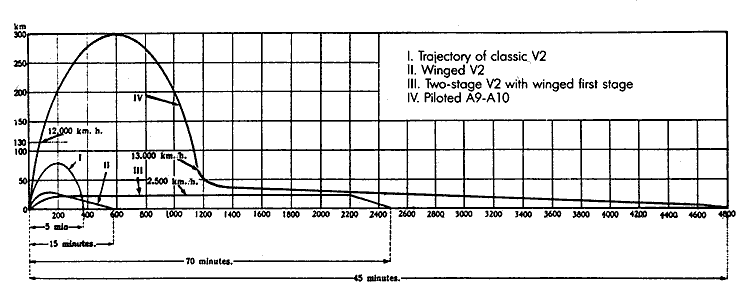 |
A9 prototype (A4b), at Peenemunde circa January 1945 |
The A9
The A9 was a winged version of the Peenemunde-designed A4 (V-2) missile. The V-2 would fly a simple ballistic trajectory after its fuel was expended, essentially like a giant artillery shell, falling on a target some 200 miles away at about three times the speed of sound (2,000 mph). Although this tremendous speed added greatly to the destructive power of the missile, there was another way it could be used.
By adding wings to the missile and modifying the guidance system, the designers redirected the kinetic energy of the falling projectile into extra range. As the rocket encountered thicker air on its descent, it would execute a high-g pullout and enter a shallow glide. In this way, speed could be traded for distance. While the rocket would reach its target at subsonic speed, and might therefore be vulnerable to defenses, it would be able to strike a target some 400 miles away only seventeen minutes after launch. Design studies began as early as 1940. In addition to the wing modifications, the A9 would have been somewhat larger than the V-2 and its engine would have produced about thirty percent more thrust.

Chart, circa 1940, showing range of winged A9 when launched from France against targets in England
Development was suspended around 1941, but several V-2s were hastily modified in late 1944 to approximately the A9 configuration under the designation A4b. (Loss of the V-2 launch sites in France and the Low Countries after the D-Day invasion made it necessary to consider ways to continue V-2 attacks on England from sites in Germany). The first A4b launch on January 8, 1945 was unsuccessful, but a second, on January 25, went better. The missile was fired vertically and reached an altitude of 50 miles and a speed of about Mach 4 -- 2,700 mph -- becoming the world's first winged supersonic guided missile. One of the wings failed on the descent and the glide portion of the trajectory was not accomplished. Appatently no further launches of the A4b were conducted.
A design study also was initiated for a manned A9. The version shown below replaced the 2,200 lb warhead of the V-2 with a pressurized cockpit. Although there are no indications of a camera payload in these drawings, some sources indicate that the intended mission of this extraordinarily high-performance manned missile was strategic reconnaissance. A ramjet engine and associated fuel tankage were to be added to provide power for cruise flight, and landing gear and flaps would enable landings on conventional runways. The radical vehicle would have had performance comparable to the US X-15 experimental hypersonic rocket plane of the late 1950s.
 |
Manned A9 with airbreathing ramjet cruise engine (highlighted) |
 |
This well-known diagram of the V-2 family has been altered to show a missing member: the two-stage A10/A4b composite. From left - standard V-2 (~280 km range); winged A4b (~580 km range); A10/A4b two-stage supersonic-glide missile (~2500 km range); A10/A9 two-stage hypersonic-glide missile (~5000 km range) |
An even more advanced version of the A9 was planned to be used to attack the US from launch sites in Europe. In order to do so, an additional booster stage, the A10, was necessary. An initial report on the concept was issued by Peenemunde's propulsion expert, Dr Thiel, on December 18, 1941, immediately after the US entered the war.
 |
A9/10 drawing dated June 10, 1941. Hypersonic A9 stage highlighted |
The intercontinental A9 was equipped with radically modified, highly-swept wings for a transatlantic glide beginning at hypersonic (greater than Mach 5) speeds and was nested in the nose of the A10. The A10 itself was about 65 feet long and was equipped with a 375,000 lb thrust rocket engine burning Diesel-grade oil and nitric acid. During its 50 second burn, it could accelerate the A9 to a speed of about 2,700 mph and an altitude of about 15 miles. With the A9 installed, the composite rocket would have stood about 84 feet tall.

Diagram shows range and trajectories of four varieties of V-2
Surprisingly, Peenemunde rocket group research on A9- influenced cruise missiles continued in the US from 1946 through about 1952 under the US Army/General Electric "Project Hermes" guided missile effort.
See: Radical Cruise Missile Experiments of Project Hermes II
Sources
History of Rocketry and Space Travel, Wernher von Braun and Frederick I Ordway III (Thomas Y. Crowell, 1966)
The Birth of the Missile, Ernst Klee and Otto Merck (George G Harrap & Co, 1965)